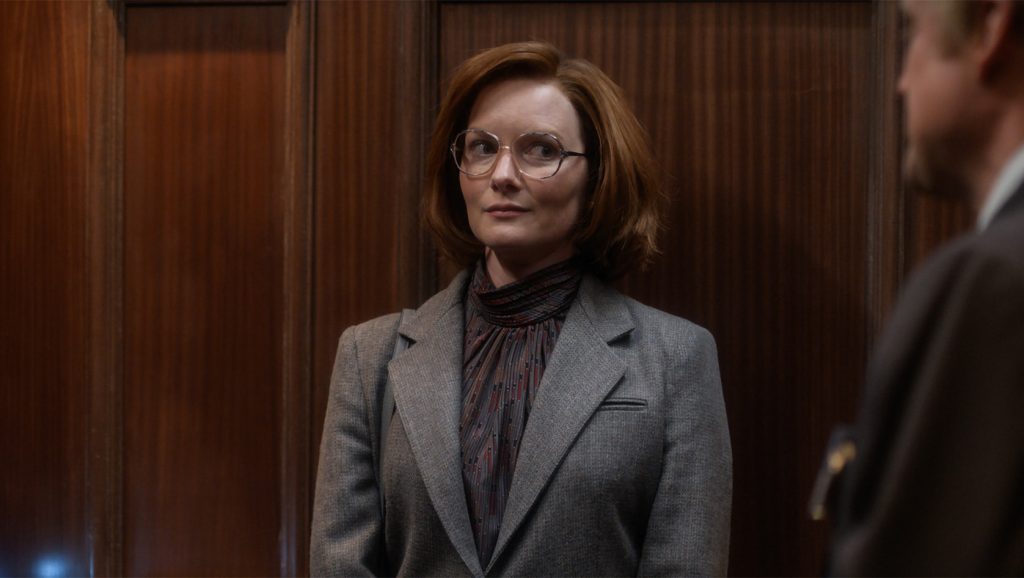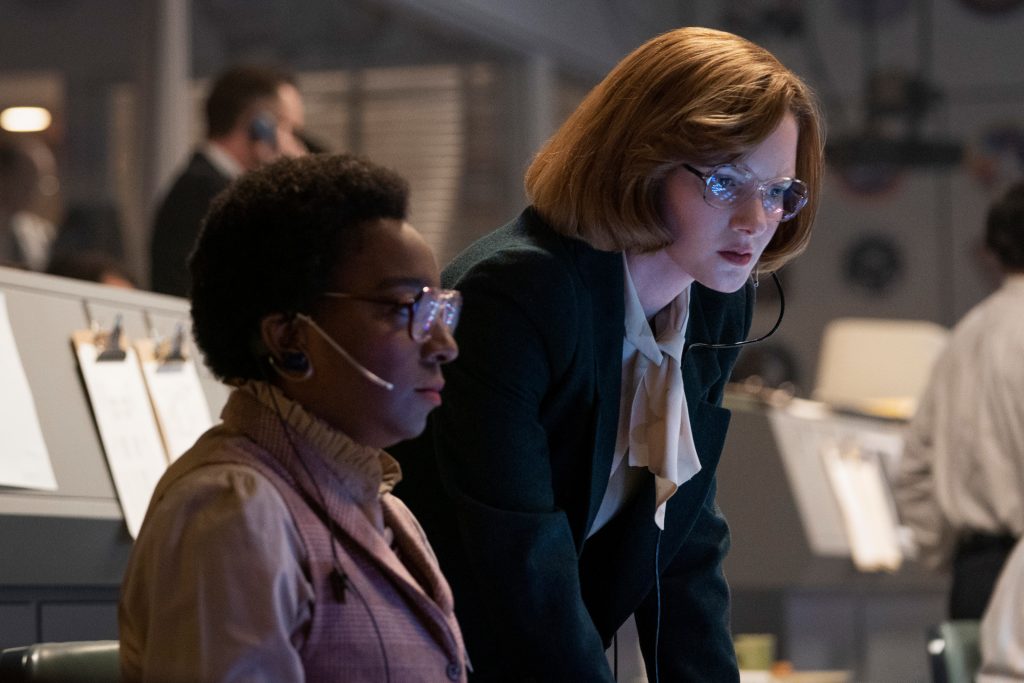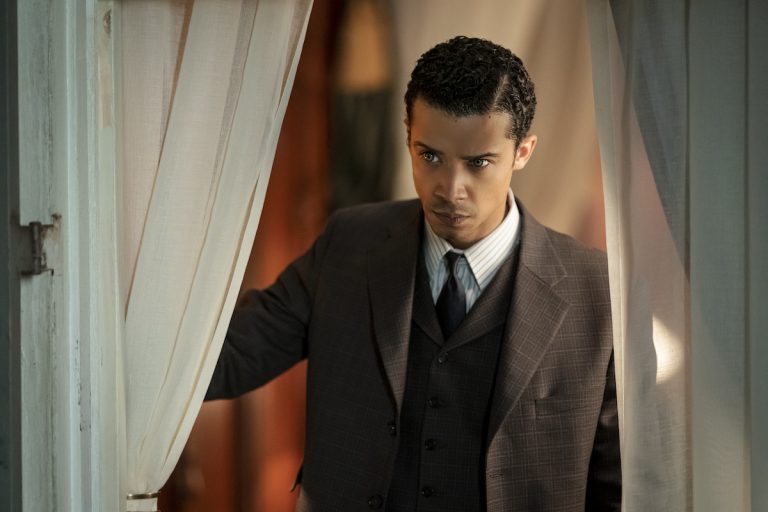For All Mankind (Season 3), Episode 3 Recap and Ending Explained: It’s interesting how For All Mankind uses the relationships of its central characters as the primary inciting incidents for some of the biggest geopolitical moments. It both makes the stakes astronomically high while also making the show, unfortunately, insular. For a show dealing with an alternate universe, global politics, as well as sci-fi accomplishments, its propensity to zero in on a few characters’ relationships and not trust the world-building (so meticulously crafted) to progress naturally feels almost disingenuous. However, the confidence of the storytellers to jump forward or backwards in time, keeping the needs of the story in the forefront, also feels very much earned. Macro time jumps between seasons are expected from For All Mankind. It’s the micro-time jumps that manage to ratchet the stakes and tension up.
FOR ALL MANKIND (SEASON 3), EPISODE 3 “ALL IN” RECAP
The show opens with a montage following Margo and Sergei’s interactions over the last 10 years during scientific conferences. In 1984, they meet at a hotel elevator in London, planning to get a drink, but Margo sidesteps the plan, citing a research lecture to attend which Sergei is also attending. In 1985, they had another elevator argument about Reaganomics and law and order, and whether such policies of law and order should be implemented after space colonization. Their interactions show Margo getting more comfortable in Sergei’s presence.
To the extent that even when she gives a fitting comeback to Sergei (which feels very below the belt), she stops the elevator door from closing and remarks, “To be continued.” Their elevator interactions in 1988 progressed to them remarking about being killed by puffer fish and cracking jokes at each other’s expense, while the physical barrier between them appears to dissolve. Margo is getting more comfortable as the viewer, like me, looks at that interaction with a mixture of happiness and dread. As they talk about raw fish and their dinner, which they are returning from, the elevator stops, and we see Sergei moving to stop the elevator door to slide one last piece of conversation in, while Margo does not stop him, almost expecting that moment, before she goes to her room.
It’s 1991. They enter the elevator. There is a healthy dose of nervous tension between the two of them. As they enter the elevator, their hands slowly touch. Margo’s face shows a shy smile, while Sergei starts pulling her closer until the elevator suddenly stops at the 4th floor and they are interrupted. Another man enters the elevator, to go to the 7th floor, and the moment is broken. The elevator reaches Sergei’s floor, a first we have seen through this entire montage, and Sergei walks out and looks back at the elevator at Margo. Her face is stony, almost embarrassed, at having been almost caught.
After the opening credits, Episode 3 begins in earnest with NASA reacting to the news of a third competitor in the space race, and much to the chagrin of Margo’s assistants, Margo also plans to have the NASA Mars mission up and running by 1994, to compete with Helios. That would mean fast-tracking through a lot of the pre-requisite operations, and while Aleida states that Sojourner-1 could be ready, both Dannies (Dani Poole and Danny Stevens) concur in the affirmative regarding their crew’s being ready. However, Bill Strausser brings up a few valid points. The basic tenet of the Mars mission was that it would be comprised of two missions, where the essentials (hubs, fuel generators, and life support systems) would be sent to the surface of Mars first, with the astronauts following in a second shuttle. But with the timeline being fast-tracked and having already missed a launch window, the habitats wouldn’t be functional for even a year.
Following Margo’s tenet of “Work the problem”, the team decides to turn the new modules built for Jamestown into the habitat modules for Mars, but that wouldn’t solve the problem of getting the modules to Mars before the astronauts. Aleida proposes a radical solution (which makes sense, but only marginally), that this pre-supply mission is to be launched at any point outside the launch window, aimed towards Venus. That would cause the shuttle to slingshot towards Mars due to orbital mechanics. While it sounds very revolutionary and cool to listen to the verses of intelligent scientists, if you think this is a sci-fi method requiring a few leaps of logic, you aren’t wrong. Slingshotting is a common technique used in Star Trek, especially as a method for time travel. Ronald D. Moore’s connection to the writers‘ room of Star Trek is again getting focused here, but credit to the writing team that it doesn’t take away from the conviction of all the actors playing the parts.
Also, Read – 9 Films To Watch If You Like Don’t Look Up On Netflix
The show’s use of real-life footage of Russian or American premiers delivering speeches in front of their respective parliaments and dialogues from the world of the show being dubbed over their words produces a hyper-realistic sensation, subsequently grounding the show in its meticulous worldbuilding. From the newsreels, we also learn that the Soviet Union had announced that they would be launching their Mars shuttle by 1994. The space race now officially has three contestants. Meanwhile, in the presidential debate, both candidates Bill Clinton and Ellen Wilson argue over the justification of spending billions of dollars on the space programme to launch the Mars mission two years earlier, with Clinton arguing that the funds would have been better spent combating poverty, and Wilson vociferously countering that the funds for the space programme do not impact the food banks, and Candidate Wilson is cognizant of that information. NASA needs extra funds injected because, as Wilson argues, “We have to press forward.” I assure you, the Russians and Helios are”.
At the retrofitted Polaris Space Station, now renamed Phoenix, Ayesa is showing Ed around the shuttle, listing all the different modifications made to make sure the Phoenix can work perfectly as a space shuttle rather than a retrofitted tourist hotel. Ed is especially impressed with the installation of mobile habitats, which could travel to wherever the best water deposits on Mars are. As Ayesa beckoned Ed to continue the tour, Karen, who had been following them, stopped by the broken elevator shaft where Sam had died a couple of months ago. It was still being constructed and retrofitted, but looking at Karen’s face, the realisation struck that past ghosts would remain. Ed is finally brought into the prime attraction of Helios, the command centre, which was the Polaris control room, now being reconditioned as the cockpit of the Phoenix. Ayesa continues his salesman pitch of treating Ed’s crew like human beings, with gourmet food being served instead of rations. In return, Ayesa asks Ed for a full manifest, saying that Karen would recruit anyone he needs, “even if they are at NASA.” And while the picture looks rosy and Ed’s sitting back in the chair results in an ear-to-ear grin across his face as he is finally at home in his element, Ed’s requirement of three pilots, two mechanical engineers, and a navigator is immediately met with resistance, as Ayesa reminds both the Baldwins that Phoenix is being run by fully automated Helios configurations. Thus, the only pilot would be Ed, leaving the rest of the crew manifest to be filled by scientists, engineers, and artists. Immediately, Ed’s controlling nature comes to the forefront as he emphatically states that he requires control of the ship whenever possible, as controlling a ship 30 million miles away from Earth with an eight-minute-long communications lag means plenty of room for things to go wrong unless he has room to improvise. Ayesa’s face doesn’t reveal his thoughts, but it is clear that he had never been spoken to so directly and the gravity of the situation so concisely before. Ayesa finally acquiesces to reworking the flight control systems according to the commander of the ship, and while both of the parties have reached an amicable conclusion, it feels like Ayesa is relinquishing a fraction of the control he already has over the operation. In no way is he going to make this a collaborative effort. Edi Gathegi is adept at showing Ayesa as a man adept at keeping his emotions in check.
At NASA, the flight training simulation of Danny Stevens by his mentor, Dani Poole, ends in a simulated fireball of a failure, as Danny fails to complete the Soujourner 1 landing simulation. Realising that he is distracted, Poole probes Danny for an explanation. Danny deflects by stating he and Amber’s marriage is progressing towards the logical continuation of the marriage, house, and then children. Poole lets Danny go early to spend some family time. While Danny accepts the leave, he is troubled about his relationship with Karen, and as the rest of his subplot will show, he comes dangerously close to imploding both his relationship and his marriage. Meanwhile, Kelly returns from her research expedition and drops by NASA before going to The Outpost to meet her parents. Her reasoning for dropping by NASA first is to meet with Dani Poole and sign up for the Mars Mission, as she had been promised by her father. Her dad’s absence didn’t deter her from joining NASA because she feels that NASA would view the importance of the Mars Mission as a scientific expedition more than Helios ever could. A strong aversion to space privatisation and strong faith in governmental institutions. This belief translates into a healthy form of confidence for Kelly, who skillfully convinces Poole that if any botanist needs to be a part of the Soujourner crew, it should be her. The reason is, that her studies of microbial life under harsh conditions would be invaluable in exploring life signs and conditions on Mars far more effectively than a botanist could.
Meanwhile, at the Outpost, which is now a Hard Rock Cafe ripoff, Danny is casually flirting with a girl while sharing drinks and regaling stories about his first job (sweeping the floor of the Outpost) and his parents, when he sees Karen, which immediately forces him to ask the girl to accompany him for a night out. Karen has come to the Outpost to meet with Aleida, who is a regular at the outpost, working and finishing up her tasks while chomping on a burger and coke. She is surprised to meet Karen, who she had heard of but never had the pleasure of meeting one-on-one. Her surprise turns to curiosity when Karen starts pitching her for a job on Helios while comparing her salary. Karen is using all the business savviness she has acquired over the last 10 years to recruit Aleida right from under Margo Madison’s nose. She had discounted Aleida’s loyalty to Margo, which she proves by dropping a moon rock in front of Karen. She explains how engineers usually aren’t the ones making the trip to the moon, but Margo Madison made it possible for Aleida Rosales, a kid from Parras De La Fuente, to reach where she currently is in her fulfilled life. And if that meant she would forever be known as “Margo’s Girl” (which Karen had mistakenly nicknamed her to clinch her acquisition), that was a small price to pay.

Meanwhile, the entire subplot of Danny Stevens’ imploding life reaches a fever pitch. Danny has managed to break into his parents’ old house and, while enjoying a drink and a dip in the pool with his new girlfriend from the bar, he is arrested for trespassing by the police. However, upon interrogation, the arresting police officer lets him go because he is the son of Gordo and Tracy Stevens, two national heroes, and Gordo’s exploits had already made him a household name among the local PD. Thus, they let Danny go, with a warning. But Danny does get an earful from Danielle Poole, who the officers had called after granting him bail. Poole is angry at Danny for sliding back to his alcoholism and his laconic ways before his marriage, and despite Danny’s pleas for forgiveness, Poole bans him from further flying and removes him from the Mars mission. Danny, who is heartbroken, enters his house and sleeps it off for the night. The next morning, he plans to take Dani’s advice about restructuring his life and family to heart and tries to tell Amber of the monumental change in his life before he is interrupted by a telephone call. It’s Ed, who had heard of Danny being benched and wasted no time in convincing him to join as co-pilot of the Phoenix. As Ed states, “Baldwin and Stevens, back in space together, except we would get there first this time”. Danny, of course, accepts, because, like his father, Gordo, Danny too favours a flight among the stars instead of confronting his demons back on Earth. Ed chooses to give Danny a purpose, a mission statement to get back on his feet, while Danielle Poole wants him to face consequences, which leads to differences between them. But Dani leaves a last parting shot to Ed—”Not everything can be cured by a trip to outer space.” Something tells me that would prove more true than even anyone would like to admit. The scene ends with Ed entering the meeting room where the recruitment of the Phoenix crew was taking place, and he announces the new co-pilot of Phoenix as Danny Stevens, much to the unease of Karen Baldwin.
Aleida had stuck by her guts and refused to leave NASA, despite the better pay, which might have made their lives easier, according to Aleida’s husband. They could have at least admitted Aleida’s father to an old age home, which Aleida angrily refuses, stating that “Mexicans take care of their family,” but her husband counters by reminding her that she isn’t at the house for the majority of the day and is not privy to the degrading mental state of her father, and maybe she should start. Meanwhile, Kelly meets with her family, where she breaks the news that she will be joining the Mars Mission, just not the one led by her father. While her father and mother were heartbroken, Ed, in a surprisingly mature move, accepted her decision. It’s a feel-good moment where each member of the family feels proud of the other’s accomplishments, with Ed and Karen especially proud of their daughter for choosing to be independent.
Checkout – The Essex Serpent (Season Finale), Episode 6: Review, Recap & Ending Explained
We finally go back to the convention, where we return to the elevator and Margo and Sergei share their first kiss. As things pick up and become hot and heavy in Margo’s hotel room, Sergei suddenly hesitates. He finally confesses that the Russians had been pressuring him to acquire more details about the US nuclear engine, as the nuclear propulsion plant by the Soviets had been failing every single time. He requests Margo to budge a bit more regarding the details, which she flat-out refuses. She reminds him that this relationship started because of an innocent exchange of scientific ideas leading to mutual progression, but nothing pertaining to military expansion. Anything related to the nuclear engine is outside of the boundaries of their agreement. However, things take a sinister turn when the door to her room is barged open by the people who have been threatening Sergei ever since this relationship started. It is not a stretch to imagine that this is the KGB, who had been surveilling Margo for the last 10 years as she had been meeting or exchanging telephonic conversations with Sergei, and they show incriminating photographs weaponised for blackmail. The head of the group, in a slimy tone, threatens Margo, stating that if her government is appraised of her actions, she would be seen as a traitor and would spend the rest of her life in prison. Margo refuses to budge, even as one of the bigger men starts strangling Sergei. Respecting her strength of character, they finally relented, giving her a day to think about her decision. They leave a card in her room, instructing her to call if she changes her mind.
Margo’s mind is heavy with thought even as she returns to NASA the next day and is met by Bill Strausser, who informs her that he is leaving for Helios and wanted to say goodbye to her face to face. Seeing no reaction from her, Strausser, a bit heartbroken, leaves. Alone in her room, Margo takes the card out and places it against a paperweight and sits back, looking at it with dread and weighing her decision. Meanwhile, Strausser reveals to a bemused Aleida as he is packing his things how Karen Baldwin had listed off his accomplishments, which made him feel validated. However, as he leaves, Bill gives Aleida his blessing, stating she is going to be a great flight director.
For All Mankind (Season 3), Episode 3 Ending Explained
The scene transitions as the timeline jump forward two years, and we see all the factions and all the storylines from the past three episodes converge here. The United States is beset with protests over a lack of jobs in the non-renewable energy sector, as all three missions launch within the same two-week window. Sojourner-1 launches from the Jamestown Base on the Moon. The Phoenix space shuttle starts its Mars injection burn as the rockets ignite and the Phoenix moves away from Earth orbit on the route to Mars. Meanwhile, the Russian space shuttle launches from their cosmodrome in the USSR. Margo Madison watches that launch from the TV in her room. Her intense looks at the engines of that space shuttle infer that she might have acquiesced to their demands, though knowing Margo, there might be an ace up her sleeve. She is informed that the president is waiting in line one on her telephone, and as Margo picks up the line, we are reintroduced to President Ellen Wilson, who congratulates Margo and then instructs her to “kick their asses”. The space race has truly begun, and the next couple of episodes are only going to increase the stakes and the action as the journey to Mars commences.









![Limbo [2020] Review – An Uneven yet Captivating Dramedy about Asylum-Seekers](https://79468c92.delivery.rocketcdn.me/wp-content/uploads/2021/07/Limbo-2020-768x561.jpg)

